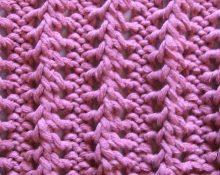Among all kinds of elastic bands that are present in knitting practice, there is one more - American. This “foreign” beauty is very voluminous, warm and unusual. Ideal for winter accessories, looks good in all colors and warm yarns. Today we will talk about all the nuances of knitting this pattern.

Features of knitting American elastic
It does not belong to the category of too lush or lacy, there are no holes in it. This is a dense relief pattern that allows you to create a lot of products. She has a rather interesting way of knitting: there are yarn overs, knitting several loops at once, and some other features. In general, knitting it is not boring, but, of course, it takes practice to get an even fabric.
Areas of use
American elastic is used for knitting hats, scarves, snoods, for processing cuffs, necklines and bottoms of the product. This pattern makes some absolutely stunning socks. Cardigans that turn out to be quite thick will look good.Wherever you need to add some originality and leave the fabric elastic, I highly recommend trying this pattern.

@en.tgchannels.org
Selection of knitting needles and yarn
To tell the truth, I don’t particularly imagine summer clothes made from light yarn knitted using this technique. But knitting is a creative endeavor, so if someone likes the idea of making shorts from cotton yarn with that texture, that would be great. I’m used to making something like this with an elastic band that I can use to insulate myself “in the cold winter.” Yarn with the addition of mohair is perfect here: having fluffed up after the WTO, the fabric will become even warmer and more interesting. As for the knitting needles, everything is simple: you should, of course, choose them depending on the thickness of the yarn with which you decide to knit. I would not recommend taking needles larger than recommended for specific threads, because... the fabric will lose its charm with looser knitting.
How to knit an American elastic band
There is no particular difficulty in this pattern. The repeat of the pattern in height is 2 rows, while the repeat in width depends on the knitting method and the effect you want to achieve.
Straight knitting needles
So, on the knitting needles you should cast on a certain number of loops - a multiple of 3 and 2 more edge loops.
- Remove the first paragraph.
- We knit 2 knit stitches, then purl one. And so on until the very end, and the last one is cut. knit purlwise.
- We turn the knitting over, after removing the edge we knit one knit stitch. We make a yarn over and knit two more knit stitches.
- With the left knitting needle we pick up the yarn over and pull the last two stitches through it. We knit to the end of the row, purl the edge stitch.
- We knit the entire fabric, alternating the first and second rows.

@YouTube
Circular knitting needles
The pattern, which is formed by stitches pulled through the yarn over, in circular knitting of this pattern lies in a mirror image when compared with rotary knitting. Pattern repeat, as in the previous case, 3 stitches for 2 rows. After casting on the required number of loops and closing them in a circle, you need to perform the following steps:
- Knit 2 knit stitches + 1 purl stitch, repeating until the end of the row.
- We make a yarn over “toward us”, knit 2 purl loops, and pull them through the yarn over. We knit the next loop purlwise.
- We alternate points 1 and 2 until the end of the canvas.
Attention! When knitting in the round, be sure to use a marker so you know where to transition from one row to the next.
Volumetric option
For those who like to knit thicker, there is a variation of the American rib. Here the rapport will be different: it is 5 loops for 2 rows. So, after casting on the required number of loops and two edge loops, we repeat the following two steps until the end of the fabric:
- Remove the edge stitch, knit 3 purl stitches and 2 knit stitches to the end of the row, then purl the edge loop.
- After removing the edge, we knit 2 purl stitches, insert a knitting needle between the second and third loops, grabbing the thread. You will get a loop, then make a yarn over, knitting three loops together behind the back wall. We knit the edge purl.

@YouTube
You can experiment with elastic bands in each new product. Fortunately, there are quite a lot of them and they are all interesting, different and beautiful. The American element in the product will not go unnoticed and will definitely make it original.


 0
0





